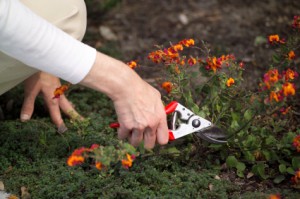
Whether your grow annuals or perennials, grooming techniques like thinning, pinching, and deadheading are quick and easy ways to keep your plants looking their best and producing flowers all season long.
Thinning refers to selectively removing some of the stems of dense, bushy plants to increase access to light and improve air circulation. If your garden contains mildew susceptible plants like garden phlox, bee balms, and delphiniums, periodic thinning can help reduce the incidence of insects and disease.
How to Thin: In the spring, examine plants for new shoots. If they appear crowded, remove a select number of stems at the soil level by thinning each plant to the four or five strongest shoots, leaving 2 to 4 inches between each stem.
Pinching refers to removal of soft tip growth, and is usually done with the thumb and forefinger. This technique encourages more uniform, compact growth, and results in plants with a more bushy form, rather than plants that are tall and gangly. Pinching can also help prevent stems from flopping over. Although pinching postpones the flowers a bit, in the end, you'll be rewarded with a greater number of blooms.
How to pinch back plants: Plants should be pinched back when they are young - in spring or early summer - before they develop long stems. Using your forefinger and thumb, or a small pair of shears, remove just the growing tips. Pinching both the upright and side stems will encourage the most uniform growth. From every stem pinched, two new branches will grow. Start pinching plants in spring and early summer, and repeat the process again a few weeks later. Don't pinch back after flower buds set or you'll discourage (rather than encourage) flowering. For plants that don't branch, like stock and celosa, pinching back isn't necessary.
Whereas pinching removes only the soft tip growth, pruning removes several inches of the plant. In addition to promoting bushier growth, it also serves as an effective way to keep plants within their designated boundaries. Variations of pruning include shearing and cutting back hard. Many perennials and shrubs benefit from pruning. Annuals flowers rarely need it, although for cascading and trailing varieties like Petunias, it can be can beneficial.
How to Prune:
Disbudding is the process of removing all but one or two flower buds on each stem, so that the plant concentrates all its energy into the remaining flowers. This results in a small number of larger flowers, rather than a large number of small flowers. Disbudding also regulate the position of the blooms on the stem so that each large flower can open unhindered by another. Gardeners commonly disbud flowers used for cut flower displays, like roses, dahlias, chrysanthemums, peonies, and carnations.
How to Disbud: Early, before the buds start to open, use a scissors or your fingers to remove all but one or two flower buds on each stem.
Deadheading involves removing spent flower blossoms using a scissors, lightweight pruning shears, or in some cases, your fingers. Although it sounds bad, it's actually a very useful technique for keeping plants productive, eliminating self-seeding, and keeping your garden looking fresh.
The purpose of a flower is to attract pollinators that will help the plant create seeds. Once this is accomplished, the plants will often stop flowering. By removing spent flowers, the energy channeled into producing seeds gets diverted back into flower, leaf, and root production. This usually extends the bloom season because plants are naturally programmed to reproduce until they are successful (or the season turns).
How to Deadhead: Use a scissors or pruning shears to remove spent flower heads. Make the cut on the stem below the flower head at the first set of leaves or flower buds you come to. For plants that have multiple flowers on a single stalk or flowers that open at different times, use your fingers to carefully pinch off only the flower that has finished blooming. To deadhead plants that produce single bloom stalks (like blazing star or delphinium) cut the stalks at or near the ground when flowers fade.
To keep your perennial flowers healthy and looking their best all season long, you need to get in the habit of scheduling some routine maintenance. Here are some strategies for upkeep that require minimal effort, allowing you to spend more time enjoying your garden, and less time working in it.